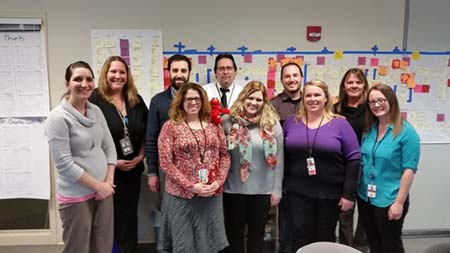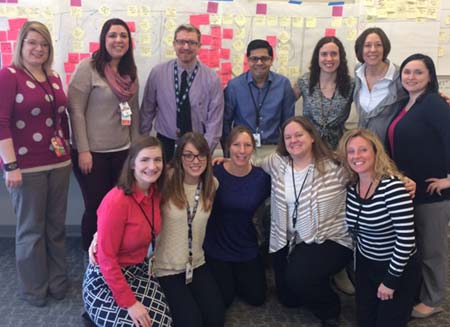
Rogers Improvement System teams tackle making the admissions process a better experience for all
03/28/17 11:02:amSometimes it takes a fresh look at what we’re doing to realize there’s big room for improvement.

After completing Rapid Improvement Events (RIEs) on non-specialty and specialty screening and MD review as well as internal transfers into and out of inpatient care, the Admissions and Transitions team’s most recent event looked at what happens when the patient arrives on campus for inpatient or residential care.

Here are a few changes underway from last week’s events:
- Trialing a condensed RN assessment that eliminates redundancies. This includes use of a shorter suicide assessment tool that has been validated to be equally as effective. The RN assessment process will continue to be evaluated to ensure the highest level of patient safety.
- Using a newly developed patient belongings form
- Enhancing involvement by the patient safety associate (PSA) role
- Finding a new more private and welcoming location for admitting steps that had been occurring with patients seated in a hallway
- Taking various parts of the admissions process to the patient instead of requiring the patient to move around. Having admissions staff meet residential patients directly in the program location, reducing time, inconvenience, and anxiety for patients and families.
The most recent improvements will be implemented at one location and then spread when they are working smoothly.
The Admissions team reduced the process from 125 steps to 15 and from 64 communications to 21. According to Claire Flox, admissions coordinator at Rogers-West Allis, all those steps became overwhelming for patients and staff. “We thought, why are we repeatedly moving patients throughout the process when we know that can provoke anxiety? We should be coming to them and making them comfortable along the way,” she adds.
The teams set goals with metrics to help them measure improvement and they are already seeing positive results. For example, before any changes were implemented, only 13% of inpatient admissions took less than 30 minutes. The new changes helped them achieve 100% under 30 minutes, and they expect to be able to sustain that goal at least 90% of the time. They are seeing the same kind of results for residential admissions compared to past performance, where only 2% of cases took less than 60 minutes from the front door to the unit door.
“We were looking at an average admission time of 77 minutes for someone once they were already accepted in our doors to get them to our unit. We were able to get that under a half hour, and even under 15 minutes a couple of times,” Claire shares. “That’s remarkable for our patients.”
Those who work with patients agree that time saved benefits patients. Breanna McDonald, RN at Rogers-West Allis, shares, “The new RN assessment saved us roughly 23 minutes so I’m able to spend more time with my patients and help the person just admitted feel more comfortable on the unit.”
Whether it’s admissions staff, nurses, psychologists, or psychiatrists, the Rogers Improvement System is getting high praise.
“The actual work we accomplished was invigorating to be able to create that much change,” comments Dr. Jennifer Carrasco, psychologist at Rogers-Brown Deer. “Equally as positive was the collaboration with other team members,” she adds.
“It was really fun to work on something that’s directed at making the institution a better place for patients and place for us to work,” shares Dr. Dylan Murray, psychiatrist at Rogers-Oconomowoc.
Paul Mueller, executive sponsor of the Rogers Improvement System, comments, “It’s powerful to see these changes happen!” He told the groups to “go spread the word that our organization is transforming.”
To learn more about the Rogers Improvement System, go to the Rogers Improvement System intranet page or see last month’s Insight story on the RIS.





